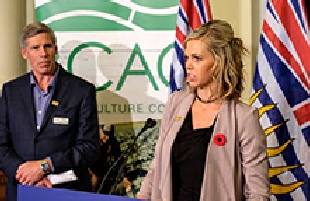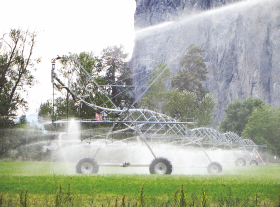VICTORIA – Keeping farm operations environmentally and financially sustainable were key to the case farm leaders made for the industry when they met with government officials in Victoria at the beginning of November.
Big enough now to span two days, BC Agriculture Day is a biennial networking event that attracted close to 80 participants from the farm sector this year for meetings with Premier John Horgan, agriculture minister Lana Popham and six of their cabinet colleagues among other government members. The formal meetings took place November 7, but many agriculture representatives arranged meetings the day before to make the most of their trip to Victoria.
Organized by the BC Agriculture Council (BCAC) with the support of proceeds from the annual gala dinner that precedes the Pacific Agriculture Show each January, the event – like the gala – is about networking.
“Ag Days is really a foundational way to meet up with ministers and people in government regarding the specific things that agriculture has near to its heart,” says greenhouse grower Stan Vander Waal, chair of the BCAC. “I think we’ve made some very good connections in that way and, overall, the meetings went exceptionally well – I heard that from both the industry side as well as the government side.”
Appropriately for agriculture, land was a fundamental element in the conversations.
“It’s something that’s always being discussed: how do we better utilize land?” Vander Waal says.
While government’s promise to consult on appropriate uses within the Agricultural Land Reserve didn’t figure into the conversations, initiatives to keep farmland affordable and limit speculation did.
Any intervention in the market that limits the price of farmland doesn’t sit well with Vander Waal, who says the focus should be on ensuring that farm properties are used for farming. Rising farmland values aren’t necessarily bad if a farmer can leverage the value to expand a viable farm operation.
Government’s role is to ensure legitimate farms are using the properties in the first place.
“We’re looking to increase land usefulness, but also to make sure that the benefits are not extended to non-
While the federal agriculture census counts anyone who grows food for sale as a farmer, BC Assessment grants farm status to owners of agricultural properties generating revenue of least $2,500 a year. Vander Waal wants government to review that threshold.
“We don’t think $2,500 is viable. No one can make a living off $2,500,” Vander Waal says. “We think it’s something that needs to have a solid review.”
Tenure is another hot topic that cropped up, which Vander Waal said would be a bellwether for how the NDP might handle other files impacting agriculture, such as new agricultural waste regulations and the high-
Access to labour, particularly skilled labour, was another key issue farm organizations raised in Victoria. The cost of labour also figured into the discussions, particularly since agriculture wasn’t included in the Fair Wage Commission the government established in October to explore ways to boost BC’s minimum wage to $15.
“We were a little disappointed to find agriculture didn’t have a seat at the table,” Vander Waal says. “It’s not so much the $15 an hour that’s really the issue, it’s the ripple effect throughout your full staff when you actually have the minimum wage going up. The expectation in general is, ‘Hey, what about me?’”
The ongoing challenge of finding skilled workers was high on the agenda of Nova Woodbury, executive director of the BC Association of Abattoirs, who travelled to Victoria with her board to raise the concerns her sector faces, which have an impact on livestock producers.
Association members met with the BC Ministry of Jobs, Trade and Technology to discuss the need for abattoir workers and skilled meat cutters in the province.
The meetings on BC Agriculture Day – last held in 2015 – seldom bear immediate fruit, but Vander Waal is optimistic.
“We’ve been very happy with the engagement so far with the government, but we have no results to really show at this point,” he says. “We need to see where the rubber is going to meet the road here.”


 Cattlemen speak out about groundwater licensing debacle
Cattlemen speak out about groundwater licensing debacle